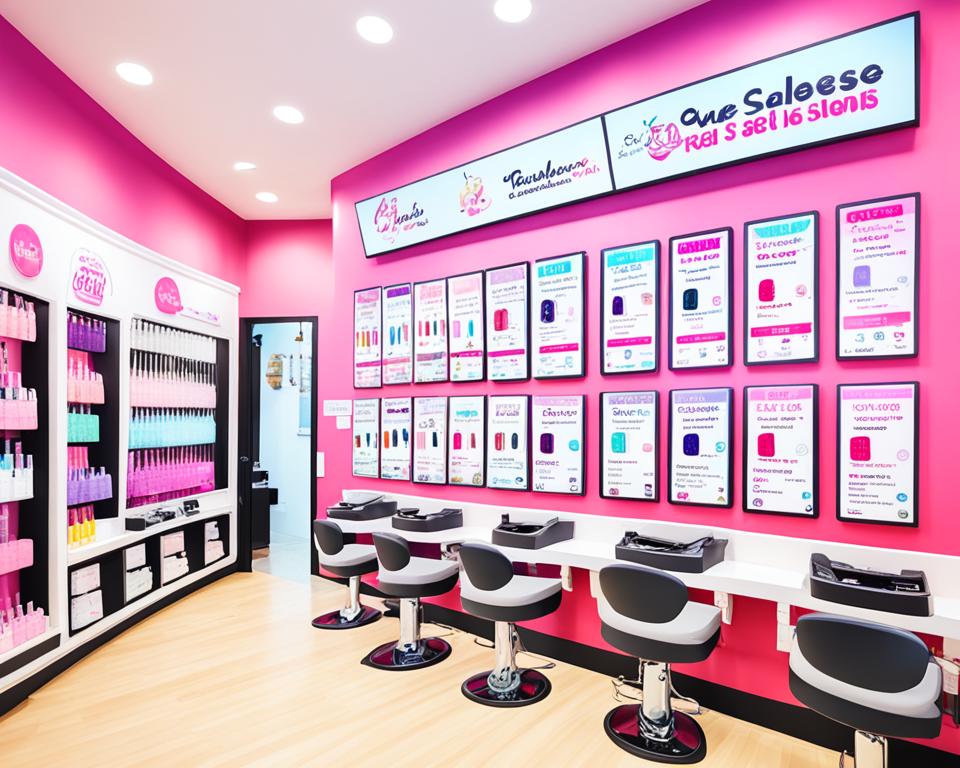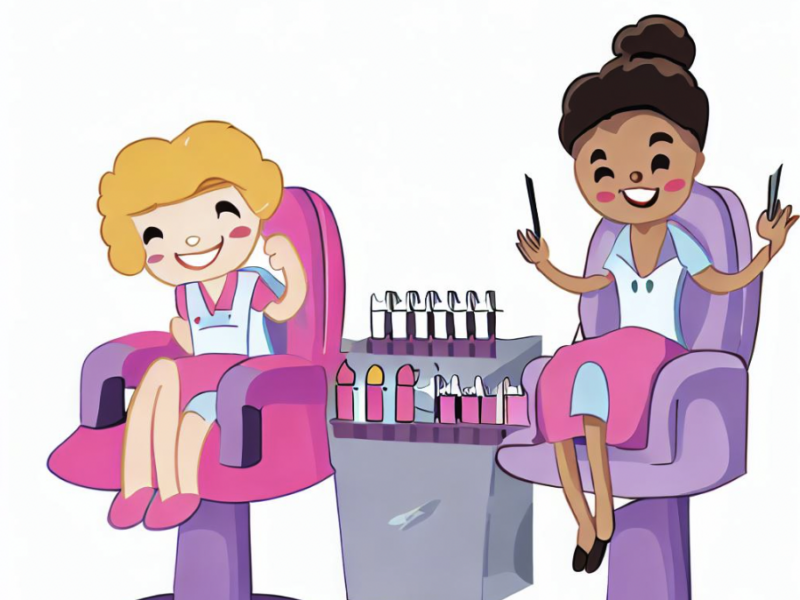Pricing strategies play a crucial role in the success of nail salons. Effective pricing can attract clients, boost profits, and help businesses stay ahead in the competitive beauty industry. There are several pricing strategies that nail salon owners can implement to optimize revenue and attract a loyal customer base. These strategies include implementing nail salon pricing models, adopting cost-effective pricing for nail services, employing competitive pricing strategies, utilizing value-based pricing for nail treatments, implementing dynamic pricing strategies, and understanding the psychology of pricing in the beauty industry.
Key Takeaways:
- Pricing strategies are essential for nail salons to attract clients and boost profits.
- Implementing nail salon pricing models can help optimize revenue and attract a loyal customer base.
- Cost-effective pricing for nail services is crucial for maintaining competitiveness in the industry.
- Employing competitive pricing strategies can help nail salons stand out in the market.
- Understanding the psychology of pricing in the beauty industry can lead to more effective pricing strategies.
Schedule Regular Price Increases
One popular pricing strategy in the nail salon industry is to schedule regular price increases. This strategy allows salon owners to adjust their prices periodically to account for rising costs and maintain profitability. By implementing yearly price increases, salon owners can ensure that their services remain competitive while also covering the increased expenses of supplies and overheads.
When considering regular price increases, it is essential for salon owners to review their profit margins and calculate the impact on overall profitability. This involves evaluating not just the mark-up, but also the costs associated with providing the services. By understanding the relationship between costs and prices, salon owners can make informed decisions about pricing adjustments.
A recommended guideline for regular price increases is a minimum of 10% on services per year. However, the exact percentage will depend on various factors such as the salon’s market positioning, location, and customer base. Salon owners may choose to implement larger or smaller increases based on their specific circumstances.
Strategic timing is crucial when implementing regular price increases. Many businesses opt to schedule these adjustments at the start of the financial year or during busy seasons to maximize profits. By considering market trends, customer behavior, and industry benchmarks, salon owners can strategically time their price changes for optimal impact.
To illustrate the importance of regular price increases, consider the following example:
| Year | Annual Sales | Price Increase Percentage | Revenue Change |
|---|---|---|---|
| Year 1 | $100,000 | N/A | N/A |
| Year 2 | $120,000 | 10% | +20% |
| Year 3 | $140,000 | 10% | +16.67% |
As shown in the table above, implementing a yearly price increase of 10% resulted in a steady growth of revenue over a two-year period. This demonstrates the positive impact of regular price adjustments in maintaining and increasing profitability.
Implementing regular price increases requires careful consideration of costs, profit margins, and market dynamics. By adopting this pricing strategy, salon owners can effectively manage their pricing structures, optimize revenue, and ensure the long-term sustainability and success of their businesses.
Utilize Odd Pricing Numbers
When it comes to pricing strategies, one tactic that can have a significant impact is the use of odd pricing numbers. This strategy takes advantage of the way our brains perceive prices and can help increase prices without customers noticing as much.
Research has shown that people tend to remember even numbers more easily than odd numbers. By setting prices that end in 1, 3, 7, or 9, salon owners can subtly increase their prices without causing customer resistance. For example, instead of increasing a service from $50 to $60, pricing it at $51 to $57 may go unnoticed by customers.
Implementing odd pricing numbers is a result of pricing psychology, leveraging our cognitive biases to positively influence purchase decisions. It allows salon owners to gradually increase prices while maintaining customer satisfaction and loyalty.
| Old Price | New Price |
|---|---|
| $50 | $51 |
| $60 | $57 |
| $80 | $79 |
As shown in the example above, using odd pricing numbers allows salon owners to increase prices subtly while still remaining competitive in the market. It’s a smart pricing strategy that can help businesses maximize their profits without negatively impacting customer perception.
Incorporating Pricing Strategies
Incorporating odd pricing numbers into your pricing strategy can be a simple yet effective way to increase revenue without customers noticing. By considering the pricing psychology behind odd numbers, salon owners can make strategic pricing decisions that align with customer perception.
- Use pricing numbers that end in 1, 3, 7, or 9 to subtly increase prices.
- Regularly review and adjust prices to meet market demands and maintain profitability.
- Monitor customer reactions and feedback to ensure pricing changes are well-received.
- Combine odd pricing numbers with other effective pricing strategies to optimize revenue.
Set Solid Foundation for Pricing
In the nail salon industry, setting a solid foundation for pricing is crucial to ensure profitability and competitiveness. By calculating the hourly charge and factoring in all overheads, salon owners can accurately determine the costs associated with each service.
Pricing should be based on various factors, including the length of time required to complete a service and the experience level of the therapists or stylists. This approach allows for fair compensation and reflects the value provided to clients.
Additionally, salon owners can consider charging extra for certain services that require additional resources. For example, clients with thick hair may need more color, which warrants an additional charge. By appropriately pricing these extras, salons can cover the expenses and maintain profitability.
To provide a better understanding, let’s take a look at an example:
| Service | Hourly Charge | Overheads | Total Cost | Pricing |
|---|---|---|---|---|
| Basic Manicure | $15 | $5 | $20 | $25 |
| Acrylic Nail Extensions | $25 | $10 | $35 | $40 |
| Nail Art | $20 | $5 | $25 | $30 |
By setting a solid foundation for pricing, nail salons can ensure that their services are priced competitively while covering all costs and maintaining profitability.
References:
- “Pricing Strategies for Nail Salons” – Nail Salon Success
- “Mastering Nail Salon Pricing” – Beauty Business Journal
- “The Importance of Calculating Overheads” – Salon Management
Conclusion
In conclusion, pricing strategies play a vital role in the success and sustainability of nail salons. By implementing effective pricing strategies, salon owners can maintain a competitive edge in the beauty industry and effectively manage their profits. Regular price increases, utilizing odd pricing numbers, setting a solid foundation for pricing, and understanding pricing psychology are all key elements in achieving these goals.
Regular price increases allow salon owners to keep up with the rising costs of supplies and overheads while maximizing profitability. Utilizing odd pricing numbers helps to subtly increase prices without alarming customers, taking advantage of pricing psychology. Setting a solid foundation for pricing, including calculating hourly charges and factoring in overheads, ensures that salon services are priced competitively and profitably.
By continually evaluating and adjusting pricing strategies, salon owners can adapt to the dynamic nature of the beauty industry and maintain a successful and competitive business. Effective pricing strategies not only attract clients but also optimize revenue and manage salon profits effectively. To thrive in the nail salon industry, it is crucial for salon owners to prioritize and invest in their pricing strategies.


